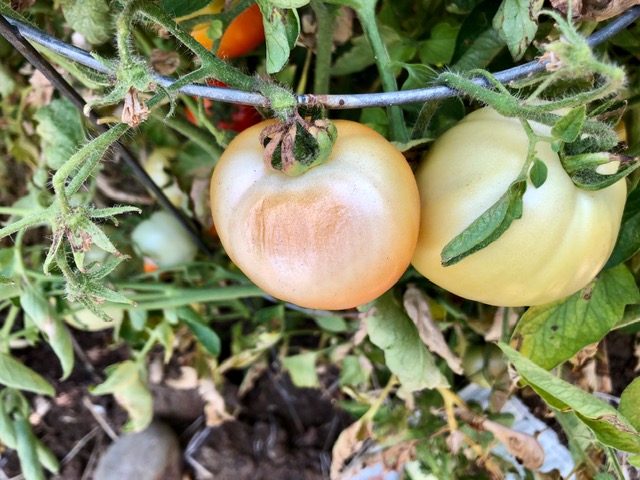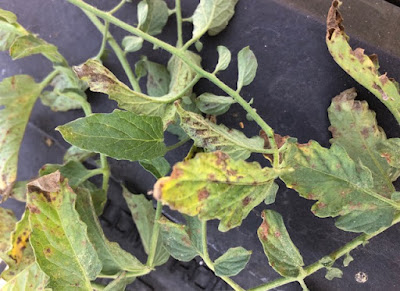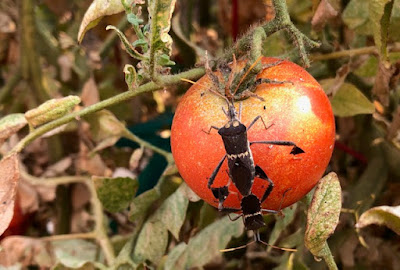
|
|
This is the easy problem to diagnose on tomatoes: Sunburn. Put up some shade
cloth to protect the ripening fruit. (Photos: Kathy Morrison)
|
What’s wrong with my tomatoes?
That July refrain can be heard all over the Sacramento region as gardeners (and farmers, too) grapple with tomato plants that look withered (or dead), flowers that never bear fruit, weird or deformed foliage or tomatoes that refuse to ripen. (And that’s not including pest damage or rodent attacks.)
Overall, most tomato plants cope OK with record heat and yoyoing temperatures. As a subtropical tender perennial, they can cope with triple-digit temperatures (to a degree). But it’s those periods of lower temperatures and high humidity that can bring on fungal disease.
This summer, many tomato issues can be linked to those recent 110-degree days.
Heat stress can “cook” tomato plants and shorten their lifespans. Perfectly normal-looking vines can suddenly shrivel up, turn brown and die when exposed to too much heat.
Some plants are too far gone to save. But others can be nurtured back to health with mulch, deep watering and temporary shade.
Other heat-related issues:
* Tomatoes won't turn fully red during high temperatures. Pick mature tomatoes and let them ripen (and redden) on the kitchen counter.
* Watch out for sunburn. Both tomato fruit and leaves can burn when exposed to too much afternoon sun. The solution: Create some temporary shade to shelter the plants during the hottest part of the day.
* Tomato flowers won’t set when temperatures stay hot (over 90 degrees) for prolonged periods. The pollen dries out. But indeterminate varieties will produce more flowers with new growth.
* Heat isn’t the only weather factor that can affect tomatoes. Lack of wind or breeze also can affect tomato set. Tomatoes generally are wind pollinated. To help with pollination, gently wiggle the tomato’s cage or trellis to shake up and spread the pollen.
* Blossom-end rot, which shows up most in hot weather, is tied to inconsistent soil moisture. Keep plants evenly hydrated. (Mulch helps with this, too.) Don’t let plants dry completely out.
Fungal woes
Other tomato problems can be traced to fungal disease. The most common are fusarium wilt and verticillium wilt, both caused by fungi in the soil. Fusarium wilt attacks the plant’s vascular system. Its symptoms include yellowing, stunting and death of seedlings, and yellowing and stunting of older plants, say UC master gardeners. Infected plants wilt readily (as the name implies), and lower leaves yellow and dry. When a stem is cut open, the interior looks brown and rotting, not white and healthy.
Verticillium wilt, which can attack more than 350 plant species, looks very similar to fusarium wilt in tomatoes. Lower or older leaves develop V-shaped yellow patches that gradually turn brown, according to the master gardeners. As the leaves die, the plant loses its foliage protection and is more susceptible to sunburn. The developing fruit can get scorched.
The master gardeners note that verticillium wilt “seldom kills tomato plants but reduces their vigor and yield.”
The fungi that causes both wilts lurks in the soil (quite possibly forever). The best way to avoid this problem is to plant wilt-resistant varieties. The V or F attached to hybrid names indicates resistance. (Unfortunately, many heirloom tomato varieties don’t have that trait.)

|
|
These tomato leaves show evidence of septoria leaf spot. It was
the only variety in this particular garden to show this (unusual
to Sacramento) problem so likely had low resistance. The fruit
was unharmed but the plant was doomed. This particular
cherry tomato plant subsequently was removed and discarded,
not composted.
|
Another fungal disease showing up this summer: Septoria leaf spot. The foliage becomes covered with black or dark brown polka dots, then yellows and dies. This is much more common in Southern states, where summer humidity is as high as the temperature. But it can happen in California, too, when the humidity spikes as we’ve seen during recent monsoonal-like spells. Overhead watering or sprinklers that wet the foliage in the afternoon also can contribute to this problem.
If caught early, remove the diseased leaves and discard. (Don’t compost.) If possible, improve air circulation around the plant so foliage can dry quickly. Mulch helps here, too; it reduces splashing water that could carry fungal spores to lower leaves.
Watch out for viruses, too
Not all foliage problems are caused by fungi. Some are viruses, spread by pests.
Curly top – beet curly top virus – is spread by the beet leafhopper, which overwinters in the foothills and descends on the Central Valley in spring. Tomatoes have no resistance to curly top and can become infected by leafhoppers feeding on their stems.
“Plants with curly top are
stunted
because growth ceases,” according to the UC IPM tomato pest management guidelines. “Plants turn yellow to bronze with purple-tinged leaves. Plants become stiff and soon die.
Green fruit
never turns red, regardless of age.”
According to UC researchers, leaves infected by curly top can be thickened, deformed, yellowed and rolled upwards. Symptomatic tomato leaves often develop purple veins.
Another virus to look out for: Tomato yellow leaf curl. Spread by a whitefly, this virus was first discovered in California in 2007 and has slowly crept into the Central Valley. It hasn’t been a problem in past years because our winters were cold enough to kill these whiteflies. As long as there’s a period with no tomato plants, this virus was kept away. But recent mild winters have allowed the whiteflies – and this virus – to persist.
Symptoms of tomato yellow leaf curl: Plants become stunted and bushy. Flowers fail to develop properly and fall off. Leaves are small and curl upwards.
“Tomato yellow leaf curl virus is undoubtedly one of the most damaging pathogens of tomato, and it limits production of tomato in many tropical and subtropical areas of the world,” according to the UC IPM website. “It is also a problem in many countries that have a Mediterranean climate such as California. Thus, the spread of the virus throughout California must be considered as a serious potential threat to the tomato industry.”
Critters like tomatoes, too

|
|
This tomato, in a photo taken last September, is not living its best life.
The leaves and fruit are under siege from spider mites (see the
webs around the stem and the stippling) and it's been chosen by two
leaf-footed bugs for an intimate moment.
|
See little webs all over your plants? Those are the telltale signs of spider mites, which thrive in dry and dusty conditions. The solution: Water. Blast the infected areas early in the day to wash away the tiny bugs.
Watch out for snails or slugs. They’ll eat anything moist, and ripening tomatoes near the ground are definitely on their menu. They lurk under plants in shady areas or under boards. Remove their hiding spots (and the snails and slugs, too). Both leave silvery slime, a sure sign of their presence.
Did something take a bite out of a ripe tomato? Look for tracks. Rats, mice, squirrels and other rodents all eat tomatoes. (Outwitting them is enough for another story.) The quickest solution? Get a cat.

